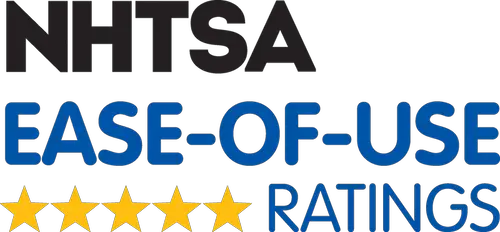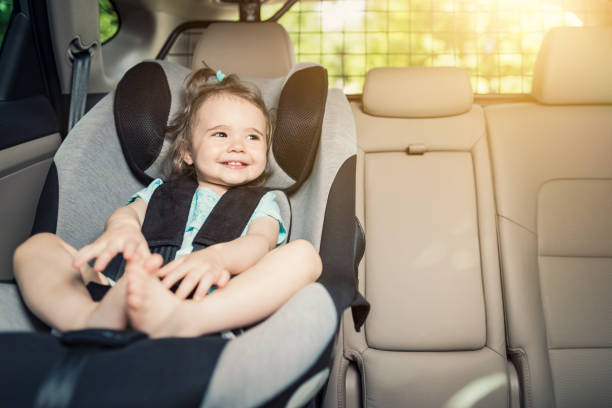Table of Contents
Many people turn to the National Highway Traffic Safety Administration’s (NHTSA) Ease of Use ratings to determine just how safe a specific car seat model is. The most important piece of information to know is that every car seat for sale in the United States has passed the federally mandated safety requirements. Therefore, the NHTSA does not rate car seats on their safety. If it did, everyone would likely own the same brand and model. Instead of offering car seat safety ratings, the agency rates the seats on their ease of use.
*This post may contain affiliate links. As an Amazon Associate we earn from qualifying purchases.
Why Are Ease of Use Ratings Necessary?
A 2011 study by the NHTSA found that nearly 50% of car seats were installed or being used incorrectly. Some studies estimate this number to be closer to 70%. When installed incorrectly, a car seat may not protect your child to its fullest capacity. Here are some of the most common mistakes parents make:
Loose installation
A car seat should move no more than one inch at the belt path where it is attached to the car when pushed or pulled from the side. The study found that 17% of forward-facing car seats moved more than two inches upon force.
Each time you are about to place your child in your car seat, pull on the unit near the belt path area. If it moves an inch or more, tighten it before seating your child inside. Place one hand on the bottom cushion and pull the latch strap with your other hand to tighten the seat in place. Even a properly installed seat can become loose over time, so be sure to test its security every time you use it.
Wrong incline angle
Rear-facing car seats must recline at an angle between 30 and 45 degrees to sufficiently protect your child. This angle allows a baby with little head control to keep his or her airway open. According to the study, 12% of rear-facing convertible car seats and 15% or rear-facing infant car seats were installed at the incorrect angle.
Check the recline angle indicators on a convertible car seat to ensure it has been adjusted correctly. On an infant seat, an adjustable foot helps keep the right incline angle. There is also a built-in level so that you can check its accuracy.
Unused tether anchor
The study also found that almost 40% of forward-facing convertible car seats were not attached to the vehicle with tether straps. The seat’s tether straps are designed to connect to an anchor in the car. In the event of a collision, the upper tether strap reduces the seat’s forward and side-to-side motion. The movement of the child’s head is reduced by up to eight inches.
To correctly use the tether straps, read your car seat’s instruction manual. The strap is located on the back, at the top, of the car seat. The anchors in the car are typically found on the cargo floor, the seatbacks, the cargo compartment’s ceiling, or the rear shelf.
Incorrect lap belt placement
When a child is sitting in a booster seat, the lap belt should be positioned across his or her upper thighs, while the shoulder belt should be positioned across the chest as opposed to the neck. Twelve-percent of children in backless boosters and 9 percent in high-back boosters were found to be sitting with the lap belt across their bellies.
The NHTSA Ease of Use ratings examine how easy or difficult it is for a parent or driver to use the car seat without error. If a car seat is easy to use, it stands to reason that it will be used properly more frequently than a car seat that is difficult to operate. With a more difficult unit, parents may not even know they are using it incorrectly. They may also become frustrated with a complicated model and simply tire of any steps they may regularly need to perform so that the car seat is in top operating condition.
Understanding NHTSA Ease of Use Ratings
The NHTSA Ease of Use Ratings allow you to search different car seat models and compare their ease of use. The ratings website, found at https://one.nhtsa.gov/nhtsa_eou/, lets you search by type of seat: infant, convertible, forward-facing, combination, 3-in-1, booster, or all. You can also choose to enter specific criteria into the NHTSA’s car seat finder feature and the site will narrow down the results for you. This feature can be found at https://www.nhtsa.gov/equipment/car-seats-and-booster-seats#find-right-car-seat-find-compare-seats. You simply type in your child’s birth date, height, and weight, and the site lists appropriate models for those criteria.
The NHTSA rates each car seat on a scale from one to five stars on several different criteria. These criteria are:
- Instructions: the clarity and content of the manufacturer’s instruction manual
- Installation features: how easy it is to use the features designed to properly secure the car seat into the vehicle
- Labels: the clarity and content of the information included on the car seat’s labels
- checkSecuring the child: how easy it is to use the features designed to properly secure the child into the car seat
The star rating system works as follows:
|
Rating |
Description |
|---|---|
|
Poor features for this category |
|
|
Below-average features for this category |
|
|
Average features for this category |
|
|
Above-average features for this category |
|
|
Excellent features for this category |
|
|
N/A |
No features in this category to rate |
You may be asking yourself if you should purchase a car seat model that rates at five stars in every category. You certainly can, but it may not be necessary. It is important that you think about what is relevant to you and your lifestyle when purchasing a car seat. For example, if you plan on using the unit in just one vehicle for as long as your child needs it, the installation features may not be that important to you; once you’ve installed it, you may never need to reinstall it. However, if you’re planning to transfer the seat from vehicle to vehicle, you may appreciate installation features that are simple to understand and that multiple people can quickly learn to use.
It is also imperative that you consider fit as a key piece of criteria when choosing the right car seat for you. Some models may work better in your car than others. This is information that the NHTSA does not provide. Some car manufacturers, however, do have recommendations for which models fit best in their vehicles. Contact your car manufacturer directly to see if this information is available to consumers. A retailer may also allow you to install a car seat into your car before you purchase it for the express reason of assessing its fit.
You can also visit a local car seat inspection station for advice. These stations are often run by local organizations like police departments and hospitals. Technicians are available to assess the safety, fit, and installation of your car seat and provide recommendations if necessary. Your local American Automobile Association (AAA) may help you find a car seat inspection station near you. Inspections are typically free of charge.
Other Sources of Safety Ratings
When deciding which car seat to purchase, the NHTSA is not the only information source available. Consumer Reports also compiles safety ratings. The organization evaluates car seats on crash protection, ease of use, the rear LATCH installation system, and the rear belt installation system. You can also search through user reviews and read about other consumers’ personal experiences with the products. To access these ratings in full, you must have a Consumer Reports membership. A one-year digital membership costs $35.
The Insurance Institute for Highway Safety (IIHS) evaluates the LATCH systems in different vehicles. The LATCH installation system helps you correctly secure your car seat in your vehicle. Research shows that LATCH systems increase the probability that a car seat will be properly installed. The IIHS rates each vehicle on how easy its LATCH system is to use. If you have children – or are planning to soon start a family – and you are in the market for a new vehicle, it may be wise to check out IIHS LATCH ratings before making a purchase. Again, the easier a restraint system is to use, the more effective it will be at protecting your child.

Before purchasing a car seat, it is important to do your due diligence. Car seats are specifically designed to save your child’s life in a collision; it is worth the extra research time it takes to find the one that will work best for your family and your car. A car seat that is easy for you to use properly is a car seat that is primed to do its job effectively. Be sure to examine the NHTSA Ease of Use ratings as part of your comprehensive research. If you still have trouble deciding, consult one of the many other information sources that are available to you: car and car seat manufacturers, customer reviews, car seat inspection stations, and other rating systems. The right car seat will protect your child and give you peace of mind while out on the road.



